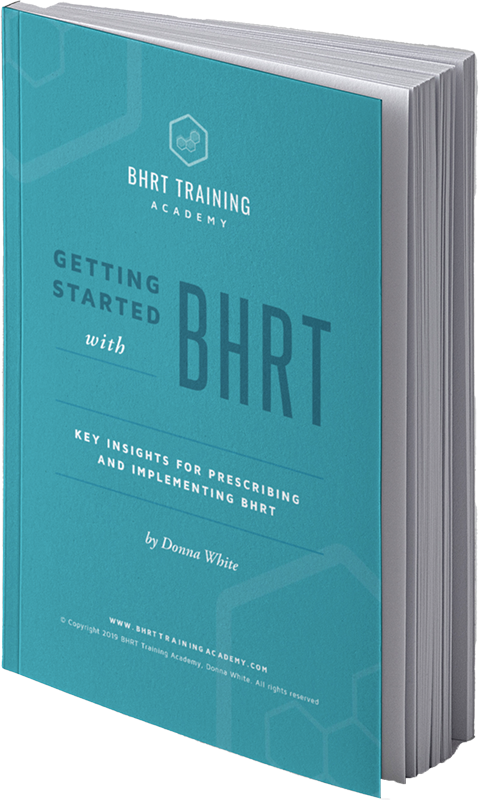How To Treat Low Androgens With BHRT

Low androgens (testosterone) can cause significant health changes in both men and women.
Even though men produce up to 20 times more testosterone than women, the role of testosterone is just as important to women’s health as estrogen and progesterone.
Along with low or fluctuating estrogen levels in menopause, and estrogen and/or progesterone imbalance in perimenopause and PMS, androgen (testosterone) levels should be checked and managed appropriately if symptoms are impacting a patient’s quality of life.
Here’s how to identify and treat low testosterone levels in women.
About Androgens (Testosterone) in Women
Androgens include testosterone and DHEA. Here, we’ll focus on testosterone. (DHEA deficiency is also common, but it is an adrenal hormone and best covered in that context.)
Testosterone gradually declines so that by age 40 production is about half the amount manufactured during the twenties, unless there is an abrupt change earlier in life, such as an accident or oophorectomy.
In both women and men, testosterone influences:
- Hair growth
- Lean body mass
- Overall strength
- Skin thickness
- Bone growth
- Bone density
- Muscle growth
- Sex drive
- Cholesterol levels
- Platelet aggregation
- Immune system
- Mood
- Insulin sensitivity
Since some testosterone gets converted to estrogen, for women a deficiency can lead to low estrogen levels triggering corresponding symptoms such as hot flashes and vaginal dryness.
Symptoms and Signs of Low Androgens
For women, testosterone is fairly steady during the monthly cycle, which is different from the rise and fall of estrogen and progesterone.
About 60% of testosterone is thought to be made by the ovaries and other sources such as conversion from adrenal hormones, creating the remaining 40%.
Women produce around 0.3mg of testosterone daily during their premenopausal years. Interestingly, this is substantially higher than the average production of estradiol, 0.025mg.
Women with low androgens are at increased risk for conditions and symptoms like:
- Breast changes
- Fertility issues
- Vaginal dryness
- Missed periods
- Low mood
- Low sex drive
- Increased aches and pain
- Hair loss
- Bone loss
- Muscle loss
- Fatigue
- Thinning skin
- Wrinkles
- Low libido
Polycystic Ovary Syndrome (PCOS) is one of the more common conditions resulting from higher than normal testosterone levels in women. Some women produce excess androgens which can cause:
- Excess body and facial hair growth
- Blood sugar imbalances
- Acne
- Infertility
Since testosterone is an anabolic hormone essential for building tissue, emotional wellbeing, and supporting energy levels if it drops to a deficient level women often experience symptoms.
Women can also notice when their testosterone is drastically lower than what they have been used to. For instance, female athletes often have high-normal testosterone levels in their twenties. If that drops to the lower end of the normal range, they may not feel like themselves.
Low androgens can have a significant impact on gynecological health, leading to vaginal dryness, painful intercourse, incontinence, and impaired sexual function.
Much like estrogen and progesterone, testosterone receptors are plentiful in the brain. Low testosterone may also cause memory or mood changes such as depression or a lack of motivation.
Considerations for Testosterone Replacement Therapy
As mentioned, declining testosterone levels is a normal condition of aging. But health practitioners should be aware of hormone imbalances resulting from other factors such as:
- Surgical – removal of ovaries
- Oral birth control
- Chemotherapy
- Ongoing, chronic stress
- Depression
- Some medications (eg: statins, SSRIs)
As for the treatment of low androgens, patients may be hesitant to take testosterone because many think it is just for men. They may be concerned that it will cause side effects such as facial hair.
The use of testosterone in women does not have virilizing effects at physiological dosing.
As discussed above, women make approximately 0.3mg of testosterone daily in their younger years suggesting dosing should be consistent with this accounting for absorption.
Verifying hormone levels through comprehensive testing should be done prior to prescribing testosterone, not just based on symptoms alone.
The recommended forms of testosterone replacement are pellets, cream, gel, or troches. Oral testosterone replacement for low androgens is not recommended, since it can cause liver toxicity.
The typical symptoms of low testosterone such as low energy, low mood, reduced sexual function, and sex drive, as well as aches and pains, are typically resolved with replacement.
While testosterone can help some with libido and is important for sexual response and arousal, sex drive in women is very complicated. It is affected by other factors such as men unloading the dishwasher, playing with the kids, or giving flowers, chocolate, etc, etc!
Beyond addressing symptoms, correcting testosterone deficiency is important for protecting the health of the brain, heart, and bones.
Discover the Benefits of Bioidentical Hormone Replacement Therapy
Hormone imbalance and decline is a natural part of aging and typically causes symptoms that can range from minor to severe.
Low androgens and other hormone imbalances can cause debilitating symptoms if not treated properly. These symptoms may be safely treated via bioidentical hormone therapy (BHRT).
It is in your best interest to learn more about this life-changing, health-promoting modality.
To get started, download our free PDF, Signs, and Symptoms of Hormone Imbalance, or book a consultation.
Enjoyed this article? Here are three more to help you:
How BHRT Can Help Patients Ease the Symptoms of Aging
BHRT is a Movement – It’s Not Going Away
The Benefits of Opening a Bioidentical Hormone Practice
This article was originally published in 2019 and has been updated in 2021.

Get the quick read ebook,
Getting Started with BHRT -
Key Insights to Prescribing and Implementing BHRT.
CME's - Earn while you learn.
